Dean Karau column: John H. Howe, Kewanee’s Civil War brigadier general
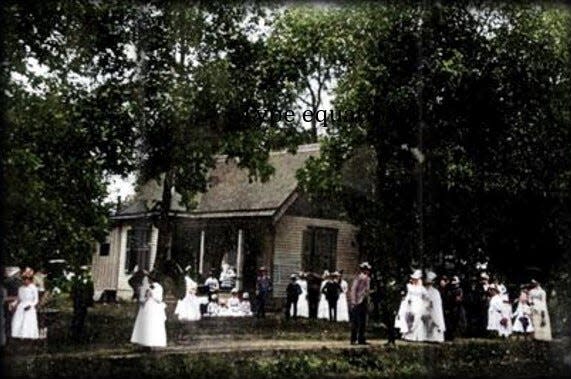
John Homer Howe was born in Riga, Monroe County, New York, in 1822. Ten years later, his family moved to Conneautille, Pennsylvania.

After helping his father clear a farm, Howe worked on the Erie Canal to earn money to attend college in Ohio. Following college, Howe studied law with a Monroe attorney, and was admitted to the bar in 1845.
Just prior to passing the bar, Howe married Julia A. Castle, a teacher he had met while in school. Howe then practiced law in Ashtabula, Lake, and Geauga Counties in Ohio for the next ten years.
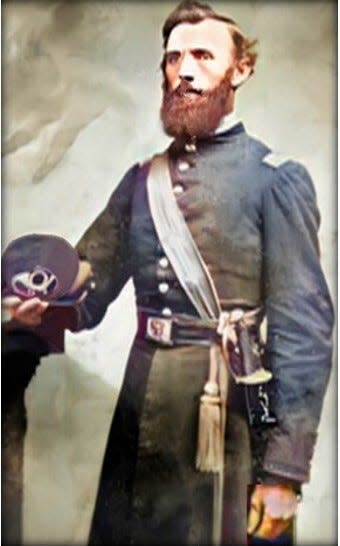
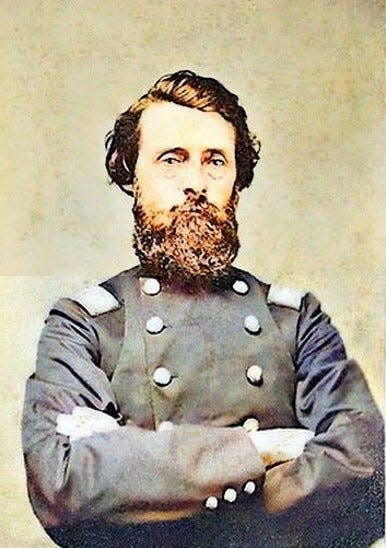
In 1855, the Howes decided to move west. Initially looking at Kansas, the unsettled political climate there led to his choosing the newly-founded village of Kewanee, where others from Ashtabula and the surrounding area had recently moved.
Howe quickly set up his law practice, sharing office space with physician G. W. Foote, while also immersing himself in the development of the village.
Howe, Foote, and two others acquired about 60 acres in the southwest quarter of Section 33, which included five acres of gently rolling, wooded land which would become West Park. The men platted the acreage and began selling plots of land around the park. Howe himself bought a block of land and built a house in which he and Julia would raise their family.
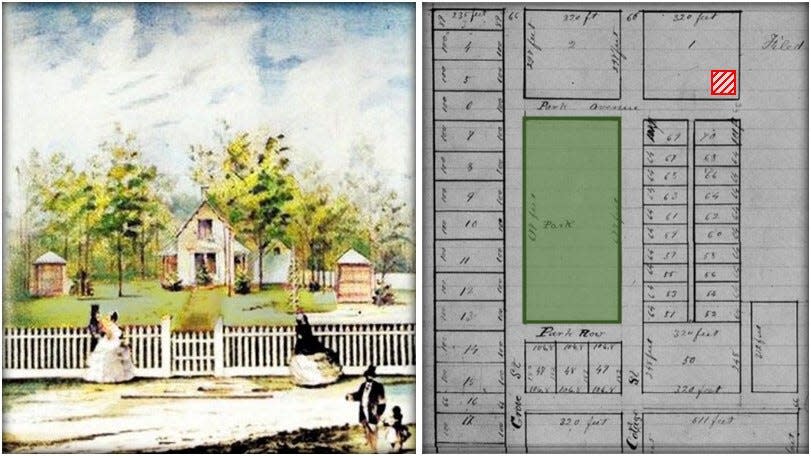
Howe also became involved in the newspaper business. Henry County’s first newspaper, the HENRY COUNTY GAZETTE, was initially published in Cambridge in 1853 but soon closed up shop. However, Kewanee’s founders recognized that the new village would soon need a newspaper, purchased what was left of the GAZETTE, started a new paper, the HENRY COUNTY DIAL, and moved it to Kewanee.
In 1855, Chauncy Bassett purchased the DIAL and took control of the business. Bassett engaged Howe as editor. But Howe, a soon-to-be Republican (the party was founded a year later), and Bassett, a staunch Democrat, had a falling-out over the issue of slavery in the western states. Bassett subsequently sold the paper to Howe and another Kewaneean.
Howe’s tenure as editor, however, was short-lived. In a landslide in 1860, Howe was elected judge of the Sixth Judicial District, and he sold his interest in the paper.
After his one-year judicial term, Howe returned to the practice of law. But in April 1861, the Civil War began when secessionist forces attacked Fort Sumter in South Carolina, just over a month after Abraham Lincoln had been inaugurated as president.
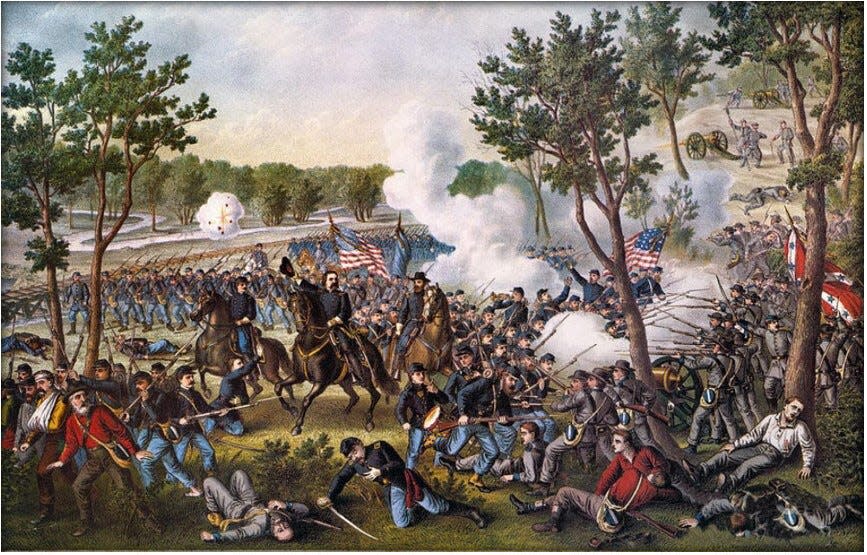
In May 1861, Howe led the effort in Kewanee to form two companies of volunteers for the war, the Kewanee Volunteers and the Kewanee Guards. But the companies were not called up and both were disbanded.
By April 1862, the Union army, after a string of victories, closed down recruiting offices. But the Confederate forces suddenly turned the tables with a number of victories in Virginia, and in July, Lincoln was forced to call for an additional 300,000 new recruits.
By August, Kewanee was ready to contribute again. On August 7, Howe set up a muster roll in his office in the Phillips Block, which attracted 29 enrollees. That evening a huge crowd gathered across from the Kewanee House, Civic leaders, led by R. P. Parrish, Ralph A. Tenney, and Howe, encouraged men to “come to the rescue of the country in this its hour of peril, and to escape the ignominy of being drafted by coming forward and putting their names upon the Muster Roll.” At the end of the night, there were 55 names on the roll. By the end of Saturday, the enrollment swelled to 111 for the company, named the Kewanee Guard. Tenney was elected captain of the company and Howe was elected first lieutenant. By the next Wednesday, a second company, the Kewanee Blues, was formed. In September, the two Kewanee companies departed for Camp Butler, east of Springfield.
The Kewanee Guard became Company A of the 124th Illinois Infantry Regiment, while the Kewanee Blues became Company F of the same regiment. Shortly after arriving at Camp Butler, Lt. Howe was appointed lieutenant colonel, second in command of the 124th.
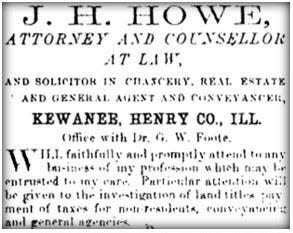
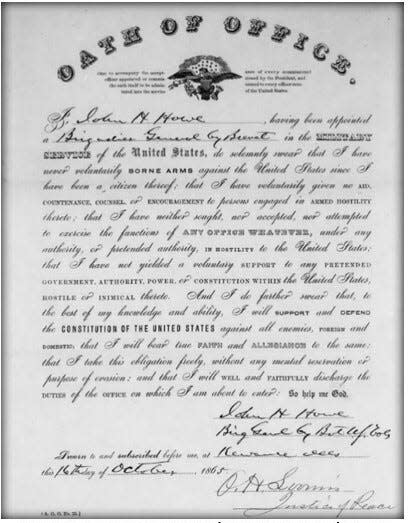
The 124th served and fought primarily in and around Vicksburg throughout the course of the war.
In December 1863, Howe was brevetted a full colonel and took command of the 124th. In March 1865, Howe was brevetted brigadier general by President Lincoln, but his commission did not reach him until after he and the regiment were mustered out in Vicksburg in July 1865 and discharged in Chicago in August.
The companies arrived home in Kewanee on a Chicago, Burlington & Quincy train in mid-September. A crowd of citizens awaited the arrival of the train at 7:00 a.m. and served a sumptuous breakfast. That night, Kewaneeans gave a general reception for the returning veterans.
Howe had kept a detailed history of the battle flag of the regiment and its various campaigns. Overall, he estimated that it marched by land and traveled by water over 4,000 miles. It engaged in 14 skirmishes, 10 battles, and sieges of 47 days and nights, and 13 days and nights, respectively. It was under the fire of the Confederate flag-waving enemy for 82 days and 60 nights.
In January 1864, Howe’s regiment won an “Excelsior” prize banner, tendered by General Leggett and signifying the 124th as the best drilled and finest regiment in the division. Leggett later praised Howe and the regiment:
“This was a splendid Regiment and splendidly officered, and deservedly earned the banner after a severe struggle. To be the best drilled and best disciplined Regiment in the old Third Division of the Seventeenth Corps, was honor enough. . . . [N]o troops did more hard marching and hard fighting. It may be truthfully said of them, they were never driven from a position, and never attempted to take a position and failed.”
Howe, however, suffered from the war, with deteriorating health and increasing anxiety. He returned to the practice of law in Kewanee, but his health continued to be problematic.
During the presidential campaign of 1868, Howe campaigned on behalf of General Ulysses S. Grant. Then, in 1869, in the hope of finding a location in which to recover his health, Howe sought and obtained an appointment from President Grant to serve as chief justice of the Wyoming Territory.
In Wyoming, Howe, among other things, worked on behalf of female suffrage. After its establishment, Howe presided over what likely was the first trial in the United States at which women were empaneled as jurors.
Unfortunately, Howe’s health did not improve, and he and Julia returned to Kewanee where he resumed his law practice. But upon the urging of his physician and friends to move south to a more friendly climate, Howe obtained an appointment on the Mexican Border Commission, and relocated to Texas.
However, after only six weeks, Howe fell ill in Laredo, Texas, and he died on April 3, 1873.
Honoring his wish to be buried in Kewanee, Julia arranged for Howe’s embalmment. She then traveled with his body some 300 miles to the nearest railroad in Austin, and then by rail to Kewanee, arriving on April 18.
His subsequent funeral was attended by a large number of friends, associates, and family; Masonic members from Kewanee, Galva, Neponset, Princeton and Galesburg; and a large number of officers and soldiers with whom he served. A procession with a band began at the Masonic Hall, proceeded to Gen. Howe’s residence, and then to the Congregational Church.

After services conducted by both the pastor and Masonic members, Howe’s remains were escorted to the Kewanee Cemetery for internment.
After his death, Howe was described as “[a] true friend, a kind husband and father, an upright judge and citizen, an able lawyer, a faithful and heroic soldier, such was Judge Howe, whose memory will ever be green in the hearts of all who knew him.”
Many Kewaneeans took up the Union cause and fought valiantly. And John Homer Howe was always leading the charge, a true leader of men.
(The Kewanee Historical Society has a collection of documents relating to John H. Howe. It includes a diary and letters written during the Civil War by Howe; letters Mrs. Howe sent to her children in Kewanee when she visited her husband in Vicksburg during the winter of 1864-65; a rare 1880 volume on the history of the 124th Regiment of Illinois Volunteers written by the regiment’s chaplain and apparently sent by the author to Mrs. Howe; other Civil War memorabilia; and articles written about Howe, including those of Dave Clarke and Larry Lock which appeared in the Star Courier.)
(You can see more of Dean Karau’s stories, photos, and videos about Kewanee on his Dusty Roads® Facebook page at https://www.facebook.com/dusty.roads.kewanee.)
This article originally appeared on Star Courier: Dean Karau: John H. Howe, Kewanee’s Civil War brigadier general

